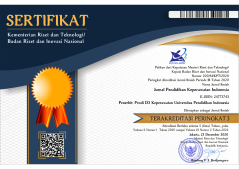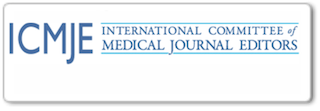Analysis of Total Flavonoid and Phenol Content from the Combination of Red Spinach (Amaranthus tricolor L.) Ethanolic Extract and Chrysanthemum Flower (Chrysanthemum morifolium) Ethanolic Extract as a Potential Anti-anemic
Abstract
Keywords
Full Text:
PDFReferences
Cai, Y., Luo, Q., Sun, M., & Corke, H. (2004). Antioxidant activity and phenolic compounds of 112 traditional Chinese medicinal plants associated with anticancer. Life Sciences, 74(17), 2157–2184.
Chillab, E. D., Talib, R. A., & Al-Awsi, G. R. L. (2019). Genetics of sickle cell anemia disorders in Baghdad City, Iraq. Indian Journal of Public Health Research and Development, 10(2), 817–822.
Cotoraci, C., Ciceu, A., Sasu, A., & Hermenean, A. (2021). Natural antioxidants in Anemia treatment. International Journal of Molecular Sciences, 22(4), 1–29.
Hanganu, D., Benedec, D., Vlase, L., Popica, I., Bele, C., Raita, O., Gheldiu, A. M., Mihali, C. V., & Țărmure, V. (2016). Polyphenolic content and antioxidant activity of Chrysanthemum Parthenium extract. Farmacia, 64(4), 498–501.
Hodaei, M., Rahimmalek, M., & Arzani, A. (2021). Variation in bioactive compounds, antioxidant and antibacterial activity of Iranian Chrysanthemum morifolium cultivars and determination of major polyphenolic compounds based on HPLC analysis. Journal of Food Science and Technology, 58(4), 1538–1548.
Ibrahim, W., Mutia, R., Nurhayati, N., Nelwida, N., & Berliana, B. (2016). Penggunaan Kulit Nanas Fermentasi dalam Ransum yang Mengandung Gulma Berkhasiat Obat Terhadap Konsumsi Nutrient Ayam Broiler. Jurnal Agripet, 16(2), 76-82.
Jahan, F., Huda, N., Islam, J., Ahmed, S., Hasan, S., Al, M., Nahar, A., Islam, B., Kanti, B., & Prosad, S. (2022). Amaranthus tricolor ( red amaranth ), an indigenous source of nutrients , minerals , amino acids , phytochemicals , and assessment of its antibacterial activity. Journal of Agriculture and Food Research, 10(October), 100419. 1-7.
Katja, D. G. (2009). Efek Penstabil Oksigen Singlet Ekstrak Pewarna Dari Daun Bayam Terhadap Fotooksidasi Asam Linoleat, Protein Dan Vitamin C. Chemistry Progress, 2(2), 79–86.
Kennouche, S., Bicha, S., Bentamene, A., Crèche, J., Benayache, F., & Benayache, S. (2016). In vitro antioxidant activity, phenolic and flavonoid contents of different polarity extracts from Chrysanthemum segetum L. growing in Algeria. International Journal of Pharmacognosy and Phytochemical Research, 8(9), 1522–1525.
Khanam, U. K. S., & Oba, S. (2013). Bioactive substances in leaves of two amaranth species, Amaranthus tricolor and A. hypochondriacus. Canadian Journal of Plant Science, 93(1), 47–58.
Liang, W.-L., Gong, D., & Zhang, W. K. (2020). The Composition of chrysanthemum extracts and their pharmacological functions. STEMedicine, 2(5), e69-e69.
Ousaaid, D., El Ghouizi, A., Laaroussi, H., Bakour, M., Mechchate, H., Es-Safi, I., Al Kamaly, O., Saleh, A., Conte, R., Lyoussi, B., & Arabi, I. El. (2022). Anti-Anemic Effect of Antioxidant-Rich Apple Vinegar against Phenylhydrazine-Induced Hemolytic Anemia in Rats. Life, 12(2), 1–14.
Sarker, U., & Oba, S. (2018). Augmentation of leaf color parameters, pigments, vitamins, phenolic acids, flavonoids and antioxidant activity in selected Amaranthus tricolor under salinity stress. Scientific Reports, 8(1), 1–9.
Sarker, U., & Oba, S. (2020). Nutritional and bioactive constituents and scavenging capacity of radicals in Amaranthus hypochondriacus. Scientific Reports, 10(1), 1–10.
Sarker, U., Oba, S., Ercisli, S., Assouguem, A., Alotaibi, A., & Ullah, R. (2022). Bioactive Phytochemicals and Quenching Activity of Radicals in Selected Drought-Resistant Amaranthus tricolor Vegetable Amaranth. Antioxidants, 11(3). 1-16.
Shi, X. F., Chu, J. Z., Zhang, Y. F., Liu, C. Q., & Yao, X. Q. (2017). Nutritional and active ingredients of medicinal chrysanthemum flower heads affected by different drying methods. Industrial Crops and Products, 104(April), 45–51.
Siregar, Y. I., & Adelina, A. (2012). Pengaruh Vitamin C terhadap Peningkatan Hemoglobin (Hb) Darah dan Kelulushidupan Benih Ikan Kerapu Bebek (Cromileptes altivelis). Jurnal Natur Indonesia, 12(1), 75-81.
Suhendra, C. P., Widarta, I. W. R., & Wiadnyani, A. A. I. S. (2019). Pengaruh Konsentrasi Etanol Terhadap Aktivitas Antioksidan Ekstrak Rimpang Ilalang (Imperata Cylindrica (L) Beauv.) Pada Ekstraksi Menggunakan Gelombang Ultrasonik. Jurnal Ilmu Dan Teknologi Pangan (ITEPA), 8(1), 27-35.
Widarti, W., Hartati, I., Harianingsih, H., & Maharani, F. (2021). Pembuatan Bubuk Bayam dengan Metode Foam Mat Dying. Jurnal Inovasi Teknik Kimia, 6(1).1-10
Zheng, J., Meenu, M., & Xu, B. (2019). A systematic investigation on free phenolic acids and flavonoids profiles of commonly consumed edible flowers in China. Journal of Pharmaceutical and Biomedical Analysis, 172, 268–277.
DOI: https://doi.org/10.17509/jpki.v9i1.58209
Refbacks
- There are currently no refbacks.
Jurnal Pendidikan Keperawatan Indonesia(JPKI) published by Indonesia University of Education. JPKI is licensed under a Creative Commons Attribution-ShareAlike 4.0 International License.
Office :
Nursing Department. FPOK UPI.
229, Dr. Setiabudhi Street. Bandung 40154
West Java , Indonesia
E-mail : jpki@upi.edu

_.png)
_.png)
_.png)











